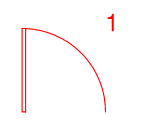Applies to:
- Revu 21
- Revu 20
- Revu 2019
- Revu 2018
Jump to other versions:
Revu keeps a running count of each markup type in the Markups List. You can keep count of that markup on the document as if you were using a sequence tool.
To create a sequence count:
- Select and copy (Ctrl+C) the markups you would like to include in the sequence.
- Go to File > New PDF
to create a blank document in Revu.
- Paste (Ctrl+V) the markups into the page.
- Select the Text Box
(T) tool.
- Place a text box in a position near the markup that you’d like the count to appear. Adjust the font size and text alignment as desired.

- Drag a rectangle over all of the markups that will be included in the sequence tool to select them.
Sequence tools need to include a text box where the sequence count will appear, so if the markup already has a text box in it you must first specify which box will contain the sequence count.
- To specify which text box will hold the sequence count, hold Ctrl and click a control point of the desired text box. The control points of the text box will turn yellow.
- Right-click one of the markups and select Group (Ctrl+G).
- Right-click the group, then go to Add to Tool Chest and select a relevant tool set.
- Go to the Tool Chest (Alt+X), right-click the new markup and go to Sequence > Define.
- The Sequence dialog box appears, where you can configure the sequencing behavior.
- Click OK.
- Select the markup and place it into your document.
Now each time you add the markup to the document, the number in the text box should update sequentially.
How-To
Revu 2019
Markup
Revu 20
Other versions of this article
Revu 2017 and older
While Bluebeam Revu keeps a running count of each markup type in the Markups list, sometimes you may want to see that count on the document as if you were using a sequence tool. A typical Punch symbol in Revu is a grouped markup comprised of an ellipse and a text box. You can see this by placing a punch symbol on a document, right-clicking on it in the Markups list and choosing Expand from the context menu.
To create your own symbol, begin by placing a markup on a page, adding a text box and grouping it with the symbol. Then, add the group to a tool set and define its sequence properties. Here’s how that process looks step-by-step:
- Open a new blank document in Revu.
- Place the original symbol on the page.
- Add a text box, and line it up in relation to the Snapshot of the Punch symbol so that it will eventually display the numbers where you want them positioned.
To help you position the text box, you can go to the Properties
tab and change the line width for the box to around .25. Simply reset it to zero once it’s positioned properly.
- Enter a number in the text box and adjust the font size and text alignment as needed.
- Group the symbol and text box by selecting both markups and using the keyboard shortcut Ctrl+G, or by right-clicking the selection and clicking Group in the context menu.
- Make sure the grouped markup is selected (click on it if you don’t see a blue border around it). In the right-hand panel, go to the Properties
tab and type a name for the markup in the Subject field.
- Save the new markup to a tool set.
- Enable the sequence functionality by going to the tool set, right-clicking the new markup symbol and choosing Define from the context menu. This opens the Sequence dialog box, where you can configure the sequence behavior.
- Click OK to save your changes and close the Sequence dialog box.
How-To
Revu 2017 & Below
Markup
